Fes, one of Morocco’s oldest and most fascinating cities, offers a glimpse into its rich history and vibrant culture. Known as the country’s spiritual capital, Fes is famous for its narrow streets, ancient medina, and traditional craftsmanship. Walking through Fes feels like stepping back in time, with every corner filled with historical monuments and unique sights.
The city is also home to the Fes Medina, a UNESCO World Heritage Site, where visitors can explore the bustling souks, visit centuries-old mosques, and admire beautiful Moroccan architecture. From the lively streets of Fes el-Bali to the quieter neighborhoods of Ville Nouvelle, Fes has something for everyone.
For those planning a trip to this remarkable city, understanding how to get there and the best ways to travel is key. In the next section, we’ll cover all the options for reaching Fes, whether you’re coming from another country or within Morocco.
Getting to Fes
Fes is accessible through various transportation options, making it easy to reach from both international and domestic locations. Whether you’re flying from another country or taking a train from a nearby Moroccan city, traveling to Fes is convenient and straightforward.
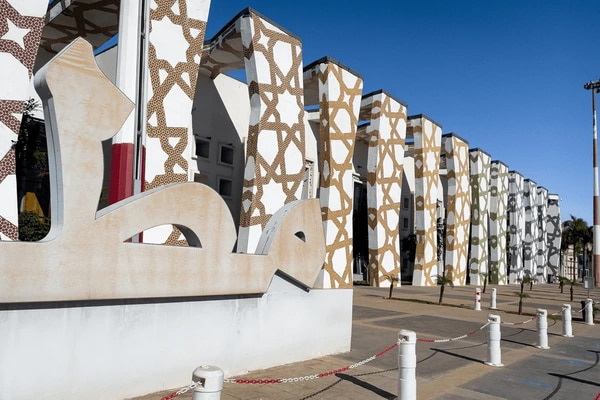
International Travel Options
For travelers coming from outside Morocco, Fes-Saïss Airport is the primary entry point. The airport serves flights from major international cities such as Paris, Madrid, and London. Depending on where you’re flying from, you may find direct flights to Fes, but many travelers opt for connecting flights through other Moroccan cities or European hubs.
Flights to Fes: Direct flights to Fes-Saïss Airport are available from several European cities, making it the easiest way for international travelers to reach the city. Airlines like Royal Air Maroc, Air France, and Ryanair frequently serve this route. Be sure to check for seasonal flights, as schedules may change.
Nearby Airports: If you’re unable to find a direct flight to Fes, nearby airports in Rabat and Casablanca offer alternatives. From Casablanca’s Mohammed V International Airport, you can take a connecting flight or travel by train or car to Fes. The journey from Casablanca to Fes takes about 4 hours by train or car, while Rabat is approximately 2 hours away.
Travel Tips for International Visitors: When flying internationally, it’s best to book your tickets early, especially during peak seasons. Consider using connecting flights through European cities or major Moroccan airports like Casablanca if direct flights are unavailable. Ground transportation from these airports is reliable and efficient.
Major International Airports Near Fes (Fes-Saïss Airport):
- Fes-Saïss Airport (FEZ) is 13 kilometers (8 miles) south of Fes.
- Direct flights available from major European cities like Paris, London, Madrid, and Brussels.
- Airlines operating at Fes-Saïss include Ryanair, Air Arabia, and Royal Air Maroc.
- Mohammed V International Airport (CMN) in Casablanca is about 4 hours from Fes by train or car.
- Rabat-Salé Airport (RBA) is around 2-3 hours from Fes, providing more flight options.
Getting to Fes from Other Cities in Morocco
For those already in Morocco, several transportation options are available to reach Fes, including trains, buses, and driving.
- Train Connections
The Moroccan railway network is an efficient and comfortable way to travel. Fes is well-connected by train to major cities like Casablanca, Marrakech, Rabat, and Tangier. The ONCF (Morocco’s national train operator) provides regular services, and tickets can be purchased online or at the station. The journey from Casablanca to Fes takes approximately 4 hours, while Rabat to Fes is a shorter 2.5-hour trip. - Bus Services
Buses are another option for reaching Fes, with companies like CTM and Supratours offering routes from cities across Morocco. While buses are typically cheaper than trains, the travel time is longer, especially on certain routes. For example, a bus ride from Marrakech to Fes can take up to 8 hours. - Travel Tips for Domestic Travelers
If you prefer convenience and speed, the train is the best option for traveling between major cities. However, buses are a more affordable choice if you’re on a budget. For those with time and a desire to explore, driving offers the freedom to stop at interesting sights along the way. - Driving Options
Renting a car and driving to Fes gives you the flexibility to explore at your own pace. Major highways, such as the A2 from Rabat to Fes, are well-maintained and clearly signposted. Driving can be a good option for those wanting to visit smaller towns or scenic areas along the way.
Travel Tips and Recommendations
Best Travel Routes for Efficiency: The fastest route to Fes is flying directly into Fes-Saïss Airport. If not available, fly to Casablanca (CMN) or Rabat (RBA) and take a train. The train from Casablanca takes 4 hours; from Rabat, 2-3 hours.
How to Make Travel Comfortable and Hassle-Free
- Book flights and train tickets early.
- Opt for first-class train tickets for extra comfort.
- Use trusted bus companies like CTM for longer bus rides.
- If driving, use GPS and pack essentials like snacks and water.
Tips for Choosing Between Travel Modes (Train vs. Bus vs. Car)
Train: Best for comfort and speed on major routes.
Bus: Budget-friendly but slower.
Car: Ideal for flexibility and exploring off-the-beaten-path locations.
Best Time to Visit Fes
Choosing the best time to visit Fes depends on what you want to do and see. The weather, festivals, and number of tourists can all affect your experience.
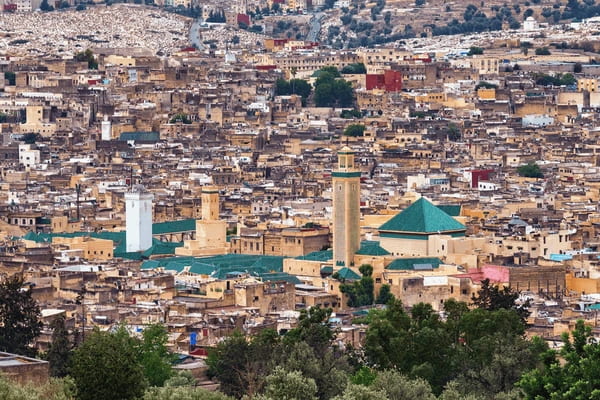
Ideal Months for Visiting
The best times to visit Fes are in the spring (March to May) and fall (September to November). During these months, the temperatures are mild and comfortable for sightseeing, with daytime highs around 70-80°F (20-27°C). These seasons are perfect for exploring the Medina, visiting cultural landmarks, and enjoying outdoor activities.
Dealing with Summer Heat
Summer in Fes, particularly from June to August, can be extremely hot, with temperatures often exceeding 100°F (38°C). While some travelers enjoy the quieter streets during this time, it’s essential to plan for the heat. Carry plenty of water, wear light clothing, and explore in the early morning or late evening when the weather is cooler.
Festivals and Events
Fes Festival of World Sacred Music (Timing and Significance): Held every spring, usually in May or June, this festival celebrates spiritual music from around the world. It brings together artists and musicians for concerts and performances in historic venues, showcasing diverse cultural traditions.
Other Notable Festivals and Local Events: Other key events include the Fes Festival of Sufi Culture, focusing on Sufi music and spirituality, and the Fes Artisanal Festival, highlighting local craftsmanship. Ramadan and Eid are also significant cultural and religious celebrations in the city.
How to Plan a Visit Around Festival Dates: Plan your visit months ahead, especially for the Fes Festival of World Sacred Music, as accommodations fill up quickly. Booking early ensures better availability and helps you experience the cultural richness of the festivals.
Tourist Crowds and Peak Seasons
Peak vs. Low Tourist Seasons: Spring and fall are the peak tourist seasons, with mild weather and many festivals. Summer is the low season due to high temperatures, while winter sees fewer tourists but cooler weather.
Advantages and Disadvantages of Visiting During Different Seasons: Spring and fall offer the best weather but larger crowds and higher prices. Summer has fewer tourists but can be uncomfortably hot, while winter is quieter with cooler temperatures, ideal for those looking to avoid crowds.
Where to Stay in Fes
Fes offers a wide range of accommodations, from traditional riads to modern hotels, ensuring that every traveler can find a place that suits their needs and budget.
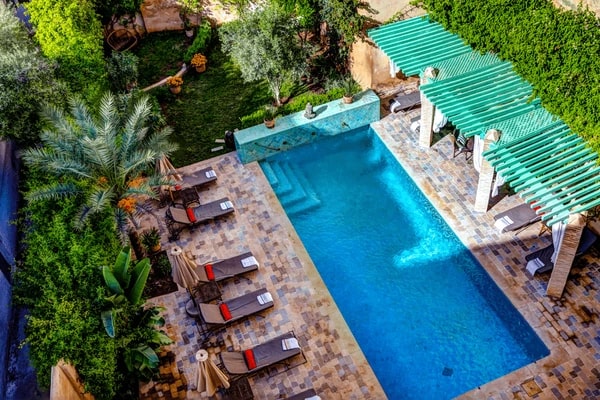
Types of Accommodations
- Traditional Riads
Riads are restored Moroccan homes with inner courtyards, often adorned with intricate tile work and decorative details. Staying in a riad provides a cultural experience, giving you a taste of Moroccan hospitality. Many riads offer luxurious amenities, such as rooftop terraces, hammams (traditional baths), and Moroccan cuisine. - Modern Hotels
For those seeking more familiar comforts, modern hotels provide spacious rooms, swimming pools, and international dining options. These hotels are ideal for families or travelers who prioritize convenience and comfort over cultural immersion. - Hostels and Budget Options
Budget-conscious travelers will find hostels and guesthouses across Fes, especially in the medina. These are great for solo travelers or backpackers looking to meet others while staying in a simple, clean environment. - Guesthouses and Airbnb Options
Guesthouses and Airbnb rentals offer budget-friendly, local experiences. They provide cozy stays, often in traditional homes, and are great for travelers seeking independence. Options range from private rooms to entire apartments, usually located in the medina or quieter neighborhoods.
Best Neighborhoods for Staying in Fes
- Fes el-Bali (Old City)
Fes el-Bali offers an authentic experience with its winding streets, historical monuments, and vibrant souks at the heart of Fes’s ancient medina. Staying here puts you close to key attractions, but be prepared for narrow alleys and a busy atmosphere. - Fes el-Jdid (New Fes)
This area is still rich in history but offers a quieter atmosphere than the bustling medina. It’s an excellent middle ground for travelers who want to experience both old and new Fes. - Ville Nouvelle (New City)
For those who prefer modern conveniences, Ville Nouvelle offers a more relaxed, contemporary experience. This area features wide streets, shopping centers, and international restaurants, making it ideal for travelers who prefer a quieter stay with easy access to amenities.
- Recommendations Based on Preferences (Culture vs. Comfort)
For cultural immersion, Fes el-Bali (Old City) offers an authentic experience with its historical charm, while Ville Nouvelle (New City) provides modern conveniences and a quieter atmosphere. - Pros and Cons of Staying in Each Area
- Fes el-Bali (Old City):
- Pros: Close to historical landmarks, vibrant atmosphere, and traditional Moroccan life.
- Cons: Narrow, crowded streets, harder to navigate, and fewer modern amenities.
- Ville Nouvelle (New City) for Modern Conveniences:
- Pros: Modern infrastructure, wide streets, hotels with more amenities, quieter and easier to navigate.
- Cons: Farther from the medina and historical sites, less authentic Moroccan feel.
- Fes el-Bali (Old City):
Recommended Riads and Hotels
- Luxury Riads: Riad Fes, Palais Amani
- Mid-range Options: Riad Laaroussa, Dar Seffarine
- Budget-Friendly: Hotel Batha, Riad Tizwa
Choosing Between Riads and Hotels
Travelers seeking an authentic cultural experience should consider staying in a riad, while those who value comfort and modern facilities may prefer a hotel. Couples may enjoy the intimate atmosphere of riads, while families might find the spaciousness of hotels more suitable.
Exploring Fes
Exploring Fes is a journey into Morocco’s cultural heart, where history and tradition are alive in every corner. The city’s ancient medina, bustling streets, and diverse neighborhoods offer countless opportunities for discovery. Fes is a city best experienced on foot, especially within the medina, but there are other ways to explore its rich tapestry of attractions.
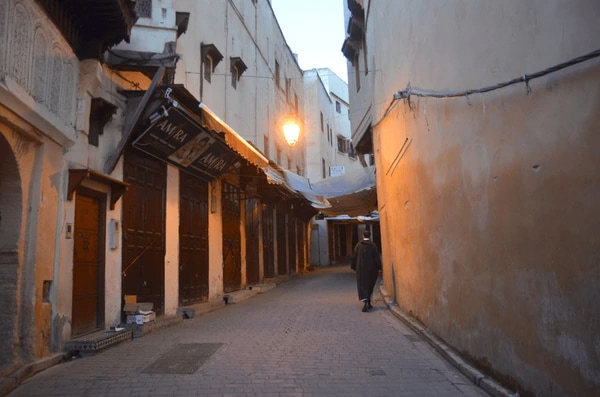
Public Transportation
Though cars and taxis cannot enter the medina’s narrow streets, public transportation is readily available in the other areas of Fes. Taxis are the most common way to get around, and they are affordable and convenient for traveling between different neighborhoods, such as Ville Nouvelle, Fes el-Jdid, and the outskirts of the city. It’s important to agree on a price before starting your trip, or make sure the taxi meter is being used. For longer distances, such as getting to the airport or visiting nearby attractions, grand taxis (larger shared taxis) or private hire vehicles are available. Public buses are also an option, though they can be crowded and confusing for tourists unfamiliar with the routes. For visitors staying outside the medina or looking to explore beyond the city, buses and taxis are reliable ways to travel.
Walking and Biking in Fes
Walking is by far the most popular way to explore the old parts of Fes, especially the medina, Fes el-Bali, where vehicles are not allowed. The winding streets and alleys of the medina are packed with shops, mosques, and historical sites, offering endless surprises around every corner. While walking, you’ll come across small souks (markets) filled with local goods like spices, ceramics, and textiles. Sturdy shoes are recommended, as the streets can be uneven and bustling with people. For those who prefer more structured exploration, there are walking tours available that cover the major landmarks and give insight into the history and significance of each site. While biking is less common in the medina due to its narrow streets, it’s a popular option in other parts of the city, such as Ville Nouvelle, where wider roads make it easier to navigate.
Guided Tours vs. Self-Guided Exploration
When exploring Fes, travelers can choose between hiring a guide or navigating the city on their own. Guided tours are highly recommended for first-time visitors, as they offer invaluable insight into the history, culture, and architecture of the city. Local guides often provide access to hidden gems and less-visited spots that you might miss on your own. A guided tour of the medina, for example, will typically include visits to important sites like the Al Quaraouiyine University, Bou Inania Madrasa, and the famed tanneries, giving context to their historical significance and local lore. On the other hand, self-guided exploration offers freedom and flexibility, allowing you to discover the city at your own pace. It’s easy to spend hours wandering the medina, stumbling upon beautiful courtyards, local artisans, and quiet corners away from the main tourist paths. If you choose to explore on your own, having a map or offline GPS is essential to avoid getting lost in the labyrinth-like streets of the medina. A mix of both guided tours and self-guided exploration is often the best way to experience Fes fully, starting with a guide to gain an understanding of the city’s layout and history before venturing off on your own to make personal discoveries.
Things to Do in Fes
Fes offers a variety of activities, from exploring historical landmarks to experiencing the city’s vibrant markets and food culture. Whether you’re interested in architecture, shopping, or outdoor adventures, Fes has something for every traveler.
Iconic Landmarks and Must-Visit Sites
Fes is home to some of Morocco’s most impressive landmarks, each with a rich history and unique beauty.
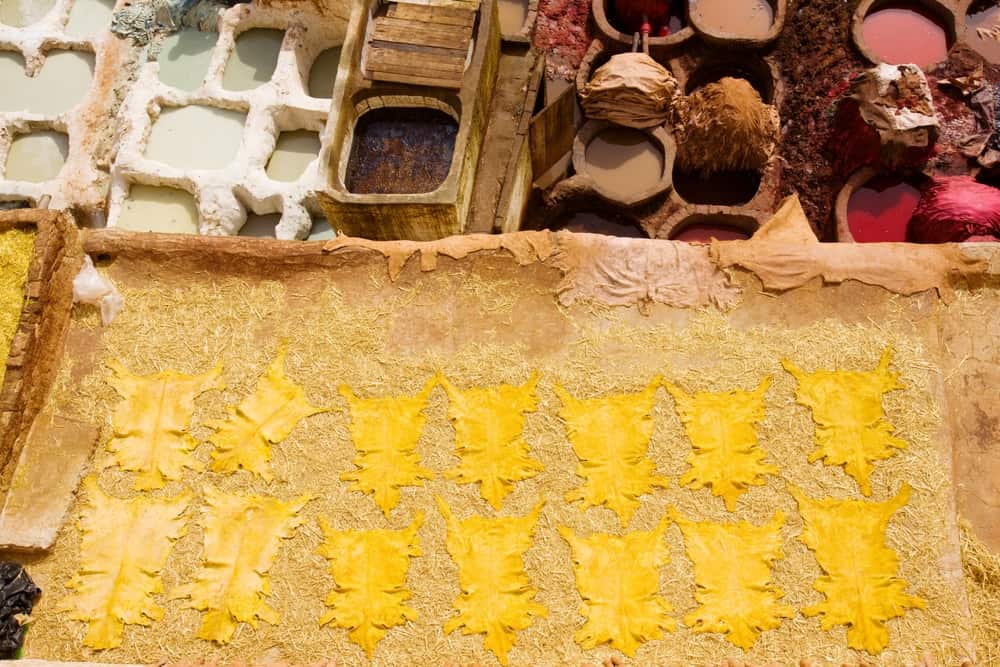
Fes Medina (UNESCO World Heritage Site)
The medina of Fes, known as Fes el-Bali, is a vast labyrinth of narrow streets, souks, and historical buildings. As a UNESCO World Heritage Site, it’s one of the largest car-free urban areas in the world, filled with hidden treasures around every corner. Visitors can spend hours wandering through its twisting alleyways, discovering local craftsmanship and historical architecture.
Al Quaraouiyine University
Founded in 859, Al Quaraouiyine University is the oldest continuously operating university in the globe. Located within the Fes medina, this prestigious institution has been a center of learning for over a millennium. Although the mosque attached to the university is only open to Muslims, the stunning architecture can be admired from the outside.
Bou Inania Madrasa
One of the most important religious schools in Fes, Bou Inania Madrasa is a masterpiece of Moroccan architecture. Its intricately carved wood and stucco details, along with its beautiful courtyard, make it a must-see for visitors. The madrasa is open to tourists, offering a glimpse into the grandeur of Moroccan education and art.
Dar Batha Museum and Nejjarine Museum of Wooden Arts & Crafts
These museums showcase Moroccan art and craftsmanship, offering a deeper understanding of the country’s rich cultural heritage. Dar Batha Museum focuses on traditional Moroccan arts, while the Nejjarine Museum highlights wooden crafts, including furniture, tools, and decorative objects.
Tanneries of Fes (Chouara Tannery)
The Chouara Tannery is one of the oldest and largest leather tanneries in Fes, known for its colorful dyeing vats. Visitors can observe the traditional leather-making process from surrounding terraces and purchase high-quality leather goods, such as bags, shoes, and jackets.
Outdoor Activities
Fes is surrounded by beautiful landscapes, offering plenty of outdoor adventures for nature lovers.
- Day Hikes to the Middle Atlas Mountains
The Middle Atlas Mountains, located a short drive from Fes, provide opportunities for hiking, picnicking, and enjoying stunning views of Morocco’s natural beauty. The mountains are known for their cedar forests and fresh air, making them a perfect day trip from the city. - Parks and Gardens
Jnan Sbil Garden, located near the medina, is a peaceful spot for a relaxing walk. This well-maintained park features fountains, exotic plants, and shaded paths, providing a calm escape from the hustle and bustle of the city. - Camel Rides and Desert Trips
Fes is a starting point for desert adventures, including camel rides and trips to the Sahara Desert. While the desert itself is a few hours away, many travelers use Fes as a base for organizing multi-day excursions into the dunes.
Culinary Experiences
Fes is a food lover’s paradise, offering a wide range of traditional Moroccan dishes and culinary experiences.
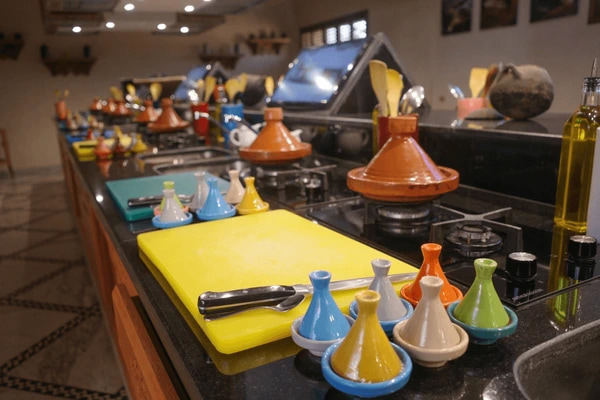
- Street Food in the Medina
The medina is full of small food stalls serving local favorites like pastilla, harira, and grilled meats. These stalls offer a quick and affordable way to taste authentic Moroccan flavors while exploring the city’s narrow streets. - Moroccan Cooking Classes
For those interested in learning how to prepare Moroccan dishes, cooking classes are available in Fes. These classes teach visitors how to make classic dishes like tagine and couscous, providing a hands-on experience in traditional Moroccan cuisine. - Best Restaurants for Authentic Moroccan Cuisine
Fes is home to many excellent restaurants where visitors can enjoy a traditional Moroccan meal. Restaurants like Café Clock and Riad Rcif offer a blend of local and international flavors in beautiful settings, while smaller eateries in the medina serve up delicious tagines, couscous, and pastries.
Shopping in Fes
Fes is famous for its vibrant markets, where visitors can buy traditional crafts, handmade goods, and souvenirs.
- Souks and Local Markets: The souks in Fes are a shopper’s dream, offering everything from leather goods to ceramics and textiles. The El Attarine Souk is one of the most popular markets in the medina, known for its spices, perfumes, and traditional Moroccan products.
- Bargaining Tips and Etiquette: Bargaining is a common practice in Moroccan markets. To get the best price, start by offering about half of the vendor’s initial price and negotiate from there. Remember to be polite and respectful throughout the process.
- Top Shopping Streets and Areas (El Attarine Souk): El Attarine Souk, located near Al Quaraouiyine Mosque, is a bustling market known for its spices, perfumes, and traditional Moroccan crafts like leather goods and ceramics. It’s a great spot for souvenir shopping, and haggling is expected. Other nearby markets like Souk el-Henna also offer unique handcrafted items.
Nightlife and Entertainment
While Fes is not known for a bustling nightlife scene, there are still plenty of ways to enjoy your evenings in the city.
- Traditional Moroccan Performances
Some riads and cultural centers host traditional Moroccan music and storytelling performances in the evenings. These events provide a great way to experience Morocco’s rich cultural heritage in a relaxed setting. - Rooftop Bars with Views Over the Medina
For a more modern experience, some rooftop bars in Fes offer drinks with stunning views of the medina. These bars provide a quiet and scenic place to unwind after a day of sightseeing. - Cultural Venues and Theaters
Cultural venues in Fes, such as the Dar Batha Museum, sometimes host art exhibitions, live music performances, and other cultural events, providing a diverse entertainment experience.
Day Trips from Fes
Fes is well-positioned for day trips to some of Morocco’s most fascinating destinations.
- Meknes
The imperial city of Meknes is just an hour’s drive from Fes and offers a rich history, stunning palaces, and ancient Roman ruins at nearby Volubilis. Meknes is often less crowded than Fes, making it a great destination for a quieter experience. - Ifrane
Known as the “Switzerland of Morocco,” Ifrane is a small mountain town famous for its European-style architecture, clean streets, and natural beauty. It’s a popular destination for skiing in the winter and hiking in the summer. - Chefchaouen
Located a few hours north of Fes, Chefchaouen is famous for its blue-painted streets and relaxed atmosphere. This picturesque town offers a completely different experience from the bustling medina of Fes, making it a perfect day trip. - Middle Atlas Mountains
The Middle Atlas Mountains, with their stunning landscapes and cool air, offer a peaceful retreat from the heat and crowds of the city. Scenic drives and nature reserves make this a great option for those seeking outdoor adventures.
Art and Culture
Fes is a hub for traditional Moroccan craftsmanship and art.
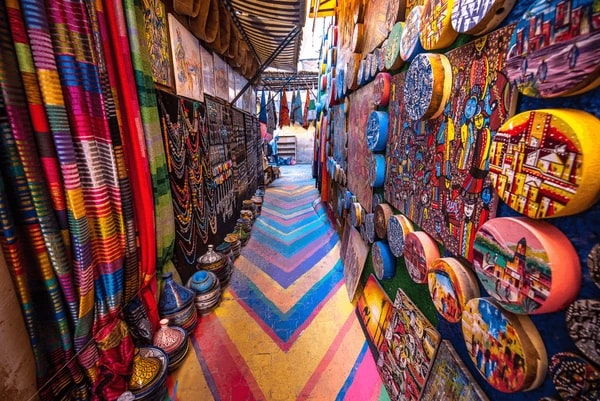
- Local Art Galleries and Exhibitions
Several galleries in Fes showcase the work of Moroccan artists, ranging from traditional crafts to modern pieces. Visiting these galleries offers insight into the artistic heritage of Fes and its role as a cultural center. - Fes Artisans and Traditional Crafts
Fes is famous for its artisans who produce exquisite pottery, mosaics, and leather goods. Visitors can watch craftspeople at work in the medina and even visit workshops where traditional techniques have been passed down through generations. - Visiting Workshops
Some workshops in Fes allow visitors to observe artisans as they create handmade goods, such as ceramics and carpets. These visits provide a deeper understanding of Moroccan craftsmanship and offer the chance to purchase unique, high-quality items directly from the makers.
Practical Tips for Fes
Before you visit Fes, it’s helpful to know some practical tips that will make your trip smoother and more enjoyable.
Currency and Payment Methods
The Moroccan dirham is the local currency. It’s advisable to carry cash when visiting the Medina, as many small vendors do not accept credit cards. ATMs are available throughout Fes, and currency exchange services are found at airports, banks, and hotels. Some larger businesses and hotels may accept credit cards, but it’s always good to have cash on hand.
Language Tips
The main languages spoken in Fes are Arabic and Berber, but French is also widely used, especially in business and tourism. English is spoken in tourist areas, but knowing a few basic phrases in Arabic or French can be helpful and appreciated by locals.
Navigating Fes Medina
The medina of Fes is a maze of narrow streets and alleyways, and it’s easy to get lost. Downloading offline maps or using a GPS app can help you navigate the area. Be cautious of people offering to guide you, as they may expect a tip in return.
Health and Safety Tips
Fes is generally a safe city for tourists, but it’s wise to take precautions. Keep your belongings secure, especially in crowded areas. It’s also important to stay hydrated, particularly during the hot summer months. If you’re traveling from outside Morocco, consider travel health insurance and check if any vaccinations are recommended before your trip.
Dress Code and Local Customs
Morocco is a conservative country, and it’s important to dress modestly, especially when visiting religious sites. Women should cover their shoulders and knees, and men should avoid wearing shorts in more traditional areas. Respect for local customs will ensure you have a positive experience during your visit.
Conclusion
Fes is a city that effortlessly blends its rich historical heritage with a vibrant present-day atmosphere. As one of Morocco’s most treasured destinations, it offers visitors a deep connection to the country’s past through its well-preserved medina, centuries-old universities, and grand madrasas. Wandering the maze-like streets of Fes el-Bali or standing in awe of the intricate architecture of Bou Inania Madrasa provides an unforgettable glimpse into the city’s cultural and intellectual significance. Whether you’re admiring the ancient craftsmanship or soaking in the spiritual ambiance, Fes invites travelers to step back in time while embracing the charm of a modern Moroccan city.
Beyond its historical landmarks, Fes is full of life and offers a range of activities to suit every interest. From vibrant street markets where you can purchase handmade crafts and local delicacies to serene gardens like Jnan Sbil for moments of quiet reflection, the city has something for everyone. Culinary enthusiasts can indulge in Moroccan cuisine, either by tasting the best street food in the medina or participating in cooking classes to learn how to prepare traditional dishes. Outdoor adventurers can explore the surrounding Middle Atlas Mountains or take day trips to nearby cities like Meknes and Chefchaouen, further enriching the experience.
Planning your trip to Fes is essential for making the most of your visit. By considering the best time to go, choosing the right accommodation, and familiarizing yourself with local customs, you can ensure a smooth and memorable journey. Fes is a city that leaves a lasting impression, with its unique blend of history, culture, and vibrant everyday life. Whether you’re drawn to its ancient medina, culinary delights, or the peaceful beauty of the surrounding landscapes, Fes promises an experience that will stay with you long after your trip ends.
FAQs
Can I visit Fes with kids?
Yes, Fes is a family-friendly destination. While the medina can be busy, older children will enjoy exploring the historical sites and markets. For younger children, it’s best to plan activities like visiting parks or taking short day trips to places like Ifrane.
Do you need a guide in Fes?
While you can explore Fes on your own, hiring a guide is recommended for first-time visitors. A guide can help you navigate the Medina’s complex layout and provide interesting insights into the city’s history and culture.
Why is Fes so popular?
Fes is known for its rich history, traditional craftsmanship, and unique cultural experiences. As Morocco’s spiritual capital and home to the world’s oldest university, Fes attracts visitors looking to explore its historical monuments, bustling markets, and authentic Moroccan lifestyle.
